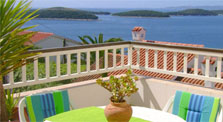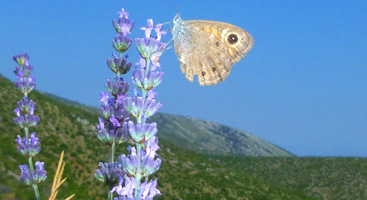About Hvar Island
The island of Hvar is compact unit
with plenty of contrasts, beautiful and inseparable in all its
varieties. I hesitate to write something about it because I wonder
if there is any sense to explore this exceptional island only by
means of maps, photographs and words. I am aware that the only way
to experience the Hvar island is to stay on it. There are a lot of
particularities of Hvar that you will not find in this text or in
any other text. Diversity of sceneries, inhabited since ancient
times, rich in history, fashonable resort, desert of fragrant
flowers are only some of the attributes of this island usually
described by using superlatives.
The coastline of Hvar has more coves than any other Adriatic
island. Opposite the town of Hvar there is a beautiful archipelago
called Paklinski islands. Thanks to Paklinski island as well as
some other small islands and rocks in its vicinity, Hvar
contributes considerably to Croatian nautical tourism. In the
hidden coves of the island there are numerous pebble and stony
beaches. Besides being ideal for sunbathing, the rocks on the
northern shore of the island also keep the secret about his
geological past.
About a hundred years ago a lot of fossils of sea fish and lizards
from Cretaceous were discovered on the flat pieces of stone which
were collected for covering roofs of various buildings. The fossils
have finished up partially in private collections of wealthy
islanders, partially in churches; many of them are also exhibited
in museums in Zagreb, London, Munich, Trieste, Vienna. A lot of
houses are still covered by pieces of stone with fossil imprints.
It is, at the same time, confusing and amazing to be aware that
many roofs on the island of Hvar contain valuable geological
remains.
In 2004 an expedition of Canadian and Croatian palaeontologists and
geologists, led by Dr Michael Coldwell and financially supported by
National Geographic, was looking for fossil remains of prehistoric
sea snakes and lizards. According to the study Gorjanovic-
Kramberger from Croatian National Museum their traces had been
discovered more than a hundred years ago. The repeated search for
fossil traces of Aigialosauros Dalmaticus Kramberger-Cenomanian
mosasauroid lizards was not successfull, however the foot-prints of
three donosauros were discovered.
These traces belong to long-necked giant dinosauros, the last of
giant sauropodus, magnificient titanosauros. That was the first
time that the existence of a trail of dinosauros footprints was
proved on the present day Dalmatian coast and islands, or ancient
Tethys sea. 90 million years old dinosauros footprints represent
one of the unsufficiently explored assets of the island of Hvar.
So, if you wish to go for a swim in this part of the island, it's
quite likely that you come across fossil imprints or some bigger
remains with strange shapes.
The area where the traces of dinosauros were discovered is situated
in the northen part of the island, not far from the Field of Stari
Grad (Velo polje).
The Field of Stari Grad, that covers an area of 1200 ha, is devided
into rectangles of 905x181m. These rectangles are noticed the best
on satellite pictures, but those are not traces of an
extraterrestial civilisation, these rectangles made of dry-stone
walls represent the best preserved ancient Greek land parcel
system. Chora of Pharos is located in the largest fertile field on
the Croatian islands. In the Field of Stari Grad there are a lot of
archeological remains from neolithic period as well as Illirian,
Greek and Roman times. Thanks to the abundance of red fertile land,
created by erosion of limestone, vine, olive and lavander are grown
in this field. The best preserved ancient Greek land parcel system,
protected by UNESCO, is surrounded by hills (higher hills on the
southern edge of the field and lower ones on the northen boundery)
and overlooked by the highest point of the island - Saint
Nicholas.
The mount Saint Nicholas, 628 m above sea level, affords a
spectacular panoramic view that you'll never forget. From this
point you can admire a big part of the island of Hvar as well as
the surrounding islands . There's nowhere else on our islands a
viewpoint that allows you to see such a wide area as it is the case
here. Those who already had the opportunity to climb to the highest
peaks of some other Croatian islands will certainly appreciate the
advantages of Saint Nicholas.
At the foot of Saint Nicholas, in the southern part of the island,
there's village Sveta Nedjelja. Well known wine producer Zlatan
Plenkovic from Sveta Nedjelja keeps a part of his wine production
in an unusual place-in the tunnel situated at an altitude of 450 m
with permanent temperature of 12 degrees Celsius; another part of
his wine production is kept in a cellar below the surface of the
sea with a window looking at underwater world. These wines are made
from grape ripened in the vineyards planted on the steep hillsides.
As the slopes are very steep (up to 50 degrees), labourers in these
vineyards must work in semi-sitting position.
The Vineyards of Sveta Nedjelja and Ivan Dolac represent a
wonderful cultivated landscape of Hvar. Cultivated or not, created
by man or by nature- it does't matter, landscape of the island of
Hvar is for me something the most beautiful I've ever seen on the
Adriatic islands . I would like to come back to the first sentence
of this text and repeat that the island of Hvar is "compact unit
with plenty of contrasts, beautiful and inseparable in all its
varieties". ".
Although the island of Hvar is one of the largest islands on the
Adriatic sea, in comparison with many Mediterranean islands it
isn't very large. It seems incredible that so many exceptional
attractions can be seen on a such a small area (299 km²): Cape of
Kabal, the bay of Stari Grad, Paklinski islands, Stari Grad with
its Field, the system of dry-stone walls, lavander fields in the
village of Brusje, the town of Hvar, vineyards in Sveta Nedjelja
and Ivan Dolac, the island of Scedro, Crvene stine (Red cliffs),
two coves of Zarace, Zacarbina with Poljica.
Rich flora of Hvar with more than 1000 species of flowering plants
changes the colours of the island from early spring to late automn.
Almost every day I bear witness to the astonishement of guests when
they smell aromatic plants. Familiar with rosemary, lavander, sage
and other aromatic herbs from their gardens with less sunshine ,
the guests don't expect so intensive smell of the same plants. On
the island of Hvar these plants grow in completely natural
conditions with plenty of sunshine, limited quantity of very
fertile land and minimum of water.
DC




